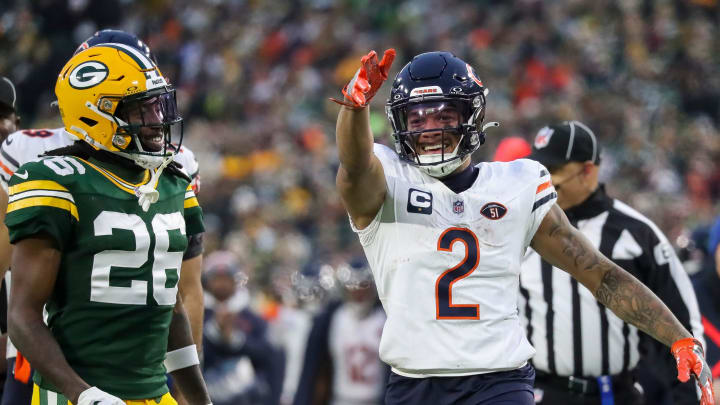Expect Balancing Act from Shane Waldron's Bears Offense

In this story:
The Bears will not assemble on the field as a full team until mid-May.
Then the look of their new offense will become more obvious. However some aspects of coordinator Shane Waldron's past attacks are going to cause changes.
"Meeting the guy my rookie year, even at the combine, I got a good sense of him," new Bears tight end Gerald Everett said. "He's like a machine. He's like a computer almost, just the way he processes information and the way he relays it to us as players.
"I couldn’t say enough about Shane. Obviously coming to Chicago, he's a big reason for that, as well."
Waldron might be like a machine, but it's not a mechanized team There will be effects from Waldron's offense.
What's known is he likes using three tight ends and the numbers say he usually strives for better overall balance than the Bears attained under Luke Getsy.
Here is what to expect from the offense as it takes shape.
Fewer DJ Moore Targets
This would happen anyway. Getting 136 targets last year was too many. It was more than all their other wide receivers combined. The blame goes, in part, to Justin Fields for not dispersing it sufficiently, but some also goes to offensive coordinator Luke Getsy and to wide receiver Darnell Mooney. This isn't about blame, though. It's about what happens going forward, and more targets at every position will likely be the path based on the way Waldron ran the Seattle offense.
Fewer Keenan Allen Targets
It will be fewer Allen targets than he was used to getting in Los Angeles, this much is certain. He had 150 targets last year, ninth most in the league.
When Waldron went from the Rams to Seahawks, second receiver Tyler Lockett had his target total drop by 22.4 catches per year for three seasons from an average of 132. The goal is better dispersal. However, his average yards per catch increased significantly from 10.5 to 16.1 in Waldron's first year, then 12.3 and 11.3.
Significant Cole Kmet Target Drop
Kmet had 90 targets last year and averaged 74 a year in his first four seasons. Waldron had only one tight end who ever was targeted more than 50 times and that was Everett in 2021, his only Seahawks.
The balanced dispersal between two or three tight ends with the Seahawks was always a thing with Waldron. Colby Parkinson had 34 targets each of his last two seasons while Noah Fant didn't go over 50 targets in those same two seasons with Seattle. And Will Dissly averaged 28.6 targets for his three seasons under Waldron, just 0.6 higher than his total the year before Waldron came to Seattle. The Bears' reported interest in talking to Georgia tight end Brock Bowers makes sense considering the emphasis Waldron had on using 13 personnel in the past but a third tight end is more of a luxury item when a team doesn't have a second defensive end who can rush the passer.
Catch and Run
Waldron's offensive design and his quarterbacks had the ball in places to receivers open enough to gain yards after the reception. This can depend on the passer getting the ball out, but Russell Wilson never ranked as a passer who got it out of his hand quickly and they still had success with yards after the catch. It picked up greatly after Wilson was no longer the quarterback, though.
They went from 19th in yards after the catch before Waldron in 2020, eventually to 11th in Waldron's final year at 2,019 yards. The closest the Bears have been to the top 20 in the league in yards per catch in the last six years was 21st in 2020 and in each of the other seasons during those six they've been 27th or worse. This was something Getsy's offense was supposed to correct but now it will be on Waldron to make it happen. Even middle of the pack like he achieved in Seattle would be a welcome change.
Backfield Workload
Considering the Bears were led in rushing yards by a quarterback the last two seasons, there will naturally be a difference in how Waldron's attack looks on the ground.
While a backfield-by-committee approach will be trumpted, it didn't look this way in Seattle once the Seahawks had Kenneth Walker on the roster. How much the Bears want to give it to D'Andre Swift will be the determining factor. Before Waldron had Walker, he did have a 50% backfield split for carries between Rashaad Penny and Alex Collins.
Less Wide Zone
The difference between the Sean McVay and Kyle Shanahan forms of offense on the ground is a wider variety of blocking schemes on running plays. The 49ers and the Bears in the last two years rely extensively on wide zone. The Rams and Seahawks have been more multiple up front.
The Caleb Williams Difference
Beyond everything Waldron brings to the offense in strategy, much will depend on Williams eyes and arm. Rookies tend to lean to favorite targets. It will be on Williams to achieve this greater balance in the offense.
The Bears will be hoping Williams can be an effective enough passer to join the minority of rookie passers who are accurate and consistent enough throwing downfield to achieve over 7.0 yards per attempt, something C.J. Stroud, Will Levis and Brock Purdy achieved as rookie starters the last two years.

Gene Chamberlain has covered the Chicago Bears full time as a beat writer since 1994 and prior to this on a part-time basis for 10 years. He covered the Bears as a beat writer for Suburban Chicago Newspapers, the Daily Southtown, Copley News Service and has been a contributor for the Daily Herald, the Associated Press, Bear Report, CBS Sports.com and The Sporting News. He also has worked a prep sports writer for Tribune Newspapers and Sun-Times newspapers.